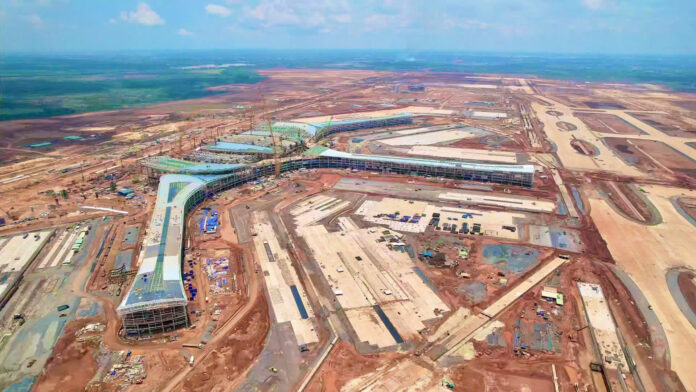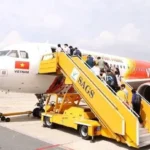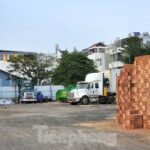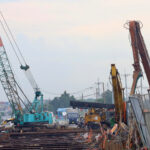According to the Vietnam Airports Corporation (ACV), the Long Thanh Airport construction is simultaneously undertaking multiple large-scale packages, requiring a substantial amount of rocks. However, the current supply of rocks delivered to the construction site only meets approximately 50% of the demand.
Severe Shortage
In 2025, the Long Thanh Airport project requires nearly 5 million cubic meters of various construction rocks, but as of mid-May, only over 1.2 million cubic meters have been supplied. This situation has left contractors struggling with a lack of construction materials, facing challenges in the construction process. Representatives from ACV stated that Dong Nai has categorized and exploited quarries to provide rocks for the airport construction. Nevertheless, some quarries have inconsistent rock quality, with a significant presence of weathered and low-strength rocks unsuitable for airport construction. Contractors and quarry owners have yet to reach an agreement on rock supply, and some quarries have even ceased operations.
In the Mekong Delta region, according to reports from local authorities, the progress of the component projects under the Chau Doc – Can Tho – Soc Trang expressway is as follows: Component Project 1 has achieved over 50%, Component Project 2 over 33%, Component Project 3 approximately 41%, and Component Project 4 more than 31%. Up to now, Soc Trang province is lagging by nearly 9% compared to the plan, and Can Tho city is about 10% behind schedule. Meanwhile, the investors of Component Projects 2, 3, and 4, including the Project Management Unit of Can Tho city, the Department of Construction of Hau Giang province, and Project Management Unit 2 (Soc Trang province), have reported challenges in obtaining sufficient sand. The People’s Committee of Kien Giang province has just decided to implement 21 large-scale projects to serve the APEC Summit Week 2027 in Phu Quoc city. These projects are estimated to require approximately 10 million cubic meters of marine sand, 3.2 million cubic meters of construction stones, and 1.4 million cubic meters of fill soil…
In Quang Nam province, the supply of sand has recently become extremely scarce. This is due to the expiration of licenses for large sand mines in Quang Nam, while the mine operated by Pha Le Company in Dai Son commune, Dai Loc district, has had to cease operations due to disputes among stakeholders. In Da Nang city, according to reports from the Project Management Unit for Transport and Agricultural Construction Works, four projects are directly affected by the shortage of construction materials: improvement and upgrade of Bien Bridge, Hoa Xuan – Cam Le wastewater collection system, Yen River dyke, and Cu De dyke.
Mr. Luong Minh Phuc, Director of the Project Management Unit for Transport Construction Works in Ho Chi Minh City, stated that all ten construction packages of the Ring Road 3 project have been implemented, with a production rate of nearly 39% of the contract value. However, the overall progress has only reached about 35%-37%. The total sand requirement for road embankment construction is estimated at 8.5 million cubic meters, of which the section passing through Ho Chi Minh City needs 6.6 million cubic meters. So far, only over 2.15 million cubic meters have been mobilized. The shortage of fill sand has become a significant obstacle to the progress of the Ring Road 3 project, a key national traffic project passing through Ho Chi Minh City.

The supply of rocks for the Long Thanh Airport construction meets only about 50% of the demand. Photo: Nguyen Tuan
“Green Channel” for Transportation
Ho Chi Minh City has promptly proposed several solutions to address the issue, including issuing an urgent directive on implementing a “green channel for sand transportation.” The goal is to supply 3.6 million cubic meters of sand from now until the end of September. Accordingly, the city’s Public Security, Border Guard, and Inland Waterway Port Authority are required to coordinate in inspecting vehicles with a streamlined process: each trip is inspected only once, and electronic documents from contractors are accepted. The Transport Department will establish a list of vehicles, schedules, and provide documentation to relevant units for unified management to avoid waterway congestion. Mr. Nguyen Van Duoc, Chairman of the People’s Committee of Ho Chi Minh City, emphasized that contractors “should not wait for materials to arrive at the construction site” but instead proactively source suitable materials and sign clear contracts with licensed quarries. The Chairman also assigned Mr. Bui Xuan Cuong, Vice Chairman of the People’s Committee, to chair meetings with relevant parties to unify the allocation of material quotas on a monthly basis until August and comprehensively address disruptions in the sand supply chain.
The Chairman of the People’s Committee of Quang Nam province has provided specific directions for each sand mine and project in the province. For the Pha Le mine, the Chairman requested the company and provincial authorities to actively coordinate and implement measures to ensure the resumption of operations. For the project on exploiting sand for common construction materials in the area of Ben Pha ferry (Tan Binh town, Hiep Duc district), BTM3 (Tra My town), and BTM5 (Bac Tra My district), relevant agencies were urged to expedite the completion of conditions for exploitation to commence in June. For mineral mines for common construction materials, licensed exploitation units were requested to promptly finalize land-related procedures and conditions for exploitation by July. For the 34 mine areas that have been auctioned: complete the necessary procedures to ensure exploitation before September…
Kien Giang province has recently proposed to the Government to pilot a special mechanism for exploiting minerals in situ as common construction materials to serve the project. Specifically, the locality plans to add two sea sand mines with a total area of 426 hectares to the planning. Regarding construction stones, the province will exploit them from the Tra Duoc Lon mine (Kien Luong district) and Hon Soc mine (Hon Dat district) and transport them to Phu Quoc. For fill soil, Kien Giang plans to utilize approximately 6 million cubic meters of material from the Cua Can Lake project and 2 million cubic meters from the Duong Dong Lake project.
Regarding the Long Thanh Airport project, the Department of Agriculture and Rural Development of Dong Nai province, along with relevant agencies, is working with mine owners to resolve land-related issues and increase mine capacity. They are also petitioning the Prime Minister to consider and approve the application of a special mechanism for mineral exploitation for the Long Thanh Airport project, serving as a basis for Dong Nai to increase the exploitation capacity of the mines up to 50%.
The Bureaucratic Stranglehold: How Red Tape is Stifling Vietnamese Businesses at Home
“A significant number of private enterprises in Ho Chi Minh City are facing obstacles to their growth due to bureaucratic red tape, high financial costs, and an uneven playing field in the business environment. These challenges are preventing them from reaching their full potential and hindering their ability to scale up their operations.”





















